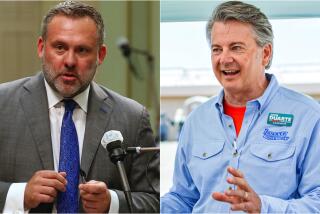California Democrats have raised nearly two times as much money as the Republicans they are trying to oust
- Share via
Reporting from Washington — If Democrats are going to regain control of the U.S. House and return Nancy Pelosi to the speakership, they must forge a path through California.
A close look at the latest money picture in the competitive congressional races shows Democratic candidates already are raising historic amounts of money, even in unexpected districts.
Here are a few major takeaways by the numbers, which suggest a Democratic wave could indeed be on the horizon.
18
The number of Democratic challengers who raised more than $500,000 by the end of 2017.
That’s a staggering number of candidates compared with previous years. Just four challengers in the 10 GOP-held seats we’re currently watching raised that much in the entire 2016 election cycle. None of them had raised $500,000 by the end of the first year.
By raising such substantial sums so early, these candidates have passed a key test for demonstrating viability: amassing enough money to run a competitive campaign and get their messages out to voters.
While Republican strategists argue that Democrats are going to spend a lot of this money fighting each other in crowded primaries, it’s also likely that many of the ads, mailers and campaign messages will focus instead on the already-vulnerable Republicans they are attempting to unseat. Donors who are getting engaged early also could consolidate behind a single Democratic candidate once the field dwindles.
$22.5 million
This is the total that the Democratic challengers in the key races raised in 2017. That’s nearly double the $13.9 million raised last year by GOP incumbents who are supposed to benefit from clout and name recognition that often allows them to raise large amounts from political action committees and wealthy donors.
We’ll say that again in case it didn’t sink in: California Democrats have raised nearly two times as much money as the Republicans they are trying to oust.
The reports cover fundraising through Dec. 31, before Reps. Darrell Issa of Vista and Ed Royce of Fullerton said they wouldn’t seek reelection. Their cash is included in the total, which means the Republicans jumping into these races will have to raise funds at a breakneck pace to catch up to the Democrats by the June 5 primary.
9
The number of California’s 14 Republican incumbents who were out-raised by their opponents.
It’s no secret Democrats have put seven of these members of Congress on lists of seats they are aiming to flip this fall. The numbers suggest most of them either aren’t prepared for a potential wave or don’t seem to be taking it seriously.
For the first time this election cycle, three Republicans reported having less money in the bank than some of their challengers, a sign of trouble since incumbents have the advantage of carrying over money they’ve socked away in previous elections. Rep. Dana Rohrabacher, who hasn’t built up much of a war chest, ended 2017 with a bank account balance that was $120,000 less than his closest competitor, Harley Rouda.
Rep. Duncan Hunter’s fundraising last quarter was particularly anemic. Hunter raised just $50,000 in the last three months of 2017 (with just a single contribution from someone living in his district). That’s less than what two Democrats and even a Republican challenger raised over the same time.
Granted, the FBI is investigating whether Hunter misused campaign funds. He also spent more than three times what he raised in the fourth quarter on legal fees.
Democrats whose districts have been identified as top priorities for the GOP to flip are not having the same problems, maintaining healthy cash leads as of Dec. 31.
5
The number of districts with surprisingly strong Democratic fundraising.
Democratic candidates from Rohrabacher’s coastal Orange County turf, Hunter’s inland San Diego County constituency and McClintock’s suburban-heavy Sacramento district are all seeing surges in funding despite Republican voter registration advantages of at least 10 percentage points.
The trend of challengers out-raising incumbents even stretches to Republican strongholds where Democrats aren’t expected to make inroads in 2018, including Rep. Doug LaMalfa’s district along the state’s northern border and Rep. Paul Cook’s district along the southern Nevada state line.
Track the California races that could flip the House »
$4,050,672
How much money the Democratic challengers gave or loaned their own campaigns in the last three months of 2017.
There are more than a few millionaires seeking to unseat Republicans this cycle, most of them in Orange County, In total, 23 of 53 Democrats running in the 10 most competitive districts pumped their own money into their campaigns last quarter.
$5 million
That’s how much Democratic candidates raised from individual donors in three months.
That’s nearly three times the $1.7 million that Republican incumbents raised from individual donors in the same time period. Even the $1.4 million the Republicans raised from political action committees and other groups was dwarfed by the money challengers raised from donors.
Why does that matter? Ask Bernie Sanders and his army of small donors that had pundits talking about a revolution in the 2016 presidential election. People willing to give any amount to a campaign are more likely to knock on doors, put a sign in their yard and encourage others to vote.
[email protected] | Twitter: @sarahdwire
[email protected] | Twitter: @cmaiduc
Read more about the 55 members of California’s delegation at latimes.com/politics
ALSO:
California could flip the House, and these 14 races will make the difference
Updates on California politics
More to Read
Get the L.A. Times Politics newsletter
Deeply reported insights into legislation, politics and policy from Sacramento, Washington and beyond. In your inbox three times per week.
You may occasionally receive promotional content from the Los Angeles Times.












